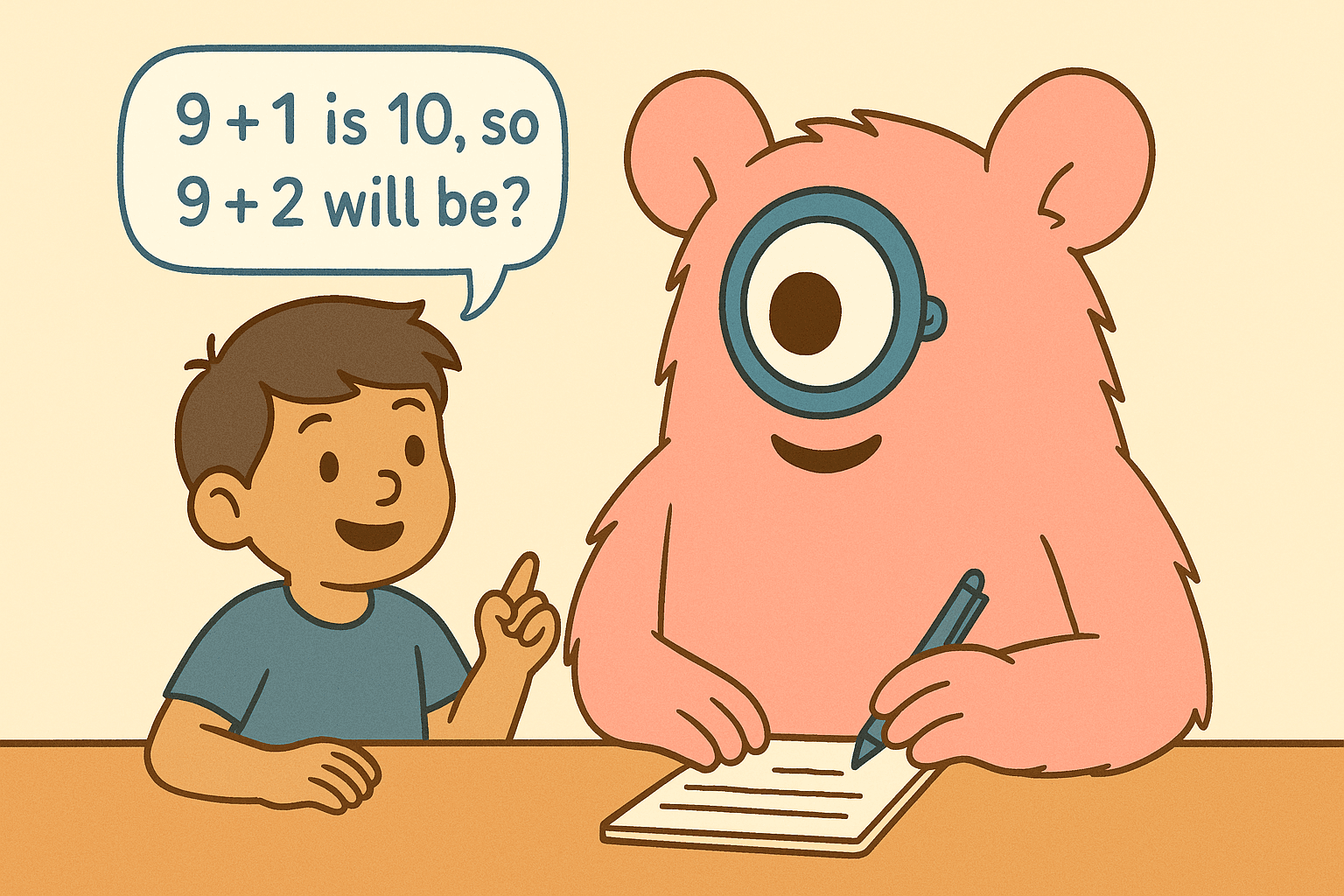9 Phrases That Calm Kids When Math Anxiety Hits.
TL;DR: Math anxiety can overwhelm working memory, making even simple tasks feel impossible. It affects many children but is especially common among neurodivergent learners such as those with ADHD, dyscalculia, or autism. Research shows that supportive language and structured calming routines can lower stress, improve self-efficacy, and help children re-engage with math. Phrases that focus on guided breathing or reinforcing Growth Mindset help address this Anxiety.
Why calming words matter when Math Anxiety Hits.
Math anxiety is more than nervousness; it’s linked to poorer performance via its impact on working memory and attention; with working memory playing a key role.
- Children with Dyscalculia are nearly twice as likely to report high math anxiety; stronger negative affect and lower self-efficacy.
- Children with ADHD display heightened math anxiety and difficulty working under time pressure.
- Children with Autism are especially sensitive to evaluative context.
Here's some encouraging news though - evidence-based moves like reappraising arousal, offering autonomy, and brief expressive writing can reduce anxiety within minutes.
Here is a list of research backed specially curated calming phrases which can help children work through their math anxiety better.

9 calming phrases (with scripts and science)
1) “Let’s pause and breathe together - slow in, slow out.”
Science: Guided breathing reduces psychological arousal and restores attentional control. Slowing the breath directly engages the parasympathetic nervous system, lowering the heart rate and cortisol levels while improving attentional control. For children with ADHD or anxiety this kind of co-regulated pause interrupts the stress cycle and frees up working memory for the task at hand.
Try: "Place your hand on the belly.
- Breathe in through your nose for a slow count of 3
- Hold gently for count of 2
- Exhale through the mouth for a slow count of 4 (Imagine blowing out a candle)
- Repeat thrice."
Why it helps: Models calm and gives children a safe entry back into the task.
2) “That nervous feeling is your body getting ready to help - let’s use it.”
Science: When children feel nervous looking at a math problem or before a test, their bodies respond with faster heart beats, sweaty palms and butterflies in the stomach. Instead of treating these sensations as danger reappraisal or reframing them as energy, can flip the script and improve math performance under pressure.
Try: “Your heart’s racing because your body is fueling up like a runner before a race."
Why it helps: Teaches children to reinterpret nervousness as helpful not harmful.
3) “Mistakes are data - your brain is growing. Which step should we try next?”
Science: Using growth mindset language helps kids see mistakes as part of learning process rather than proof of 'not being good at math.' Its effects are strongest when it boosts intrinsic motivation, adaptive failure attributions, and self-efficacy.
Try: “This mistake isn't a failure, its a clue that your brain is learning”
Why it helps: Children learn that errors are signals of growth, not verdicts of ability.
4) “You choose: start with the picture, the numbers, or the words.”
Science: Giving children meaningful choices is the cornerstone of autonomy-supportive teaching. When children feel a sense of control their engagement and persistence increases reducing stress and resistance.
Try: “You’re in charge: Take your pick with drawing, numbers or reading?”
Why it helps: Restores control when anxiety makes children feel trapped.
5) “No rush - accuracy over speed. We can ignore the timer.”
Science:Time pressure magnifies math-anxiety. When a clock is ticking the brain shifts from flexible problem solving to 'fight or flight' mode often leading to mistakes blanking out and disrupting strategy selection. Removing the time pressure restores their sense of safety making learning easier.
Try: "Turn the timer over and say, “We don't need to race let's just solve”
Why it helps: Removes a key stressor especially for ADHD or dyscalculia learners.
6) “Let’s jot down any worries for two minutes - then we’ll solve.”
Science:Writing down worries before a task frees working memory and boosts performance. Intrusive thoughts like 'what if i mess up' or 'I will look dumb' eat up working memory leaving less energy for problem solving. Moving fear from mind to the page helps children clear mental space and reduce the load on attention and working memory.
Try: “Write every worry in your head on this sheet; once down fold it up or toss the sheet”
Why it helps: Reduces intrusive thoughts so the brain can focus on math.
7) “Explain it your way - I’ll write while you talk.”
Science:Externalizing thinking reduces working memory load especially for ADHD learners, because holding ideas in your mind and writing them down at the same time overloads working memory. Speaking thoughts out load as someone else captures it lightens the load.
Try: “Pretend you are the teacher. Talk me through it, while I do the writing.”
Why it helps: Removes the stress of being evaluated while writing.
8) “If one way is bumpy, we’ll switch tools - number line, blocks, or a visual.”
Science: Children who only have one path in a math problem often hit frustration quickly. It that path fails it often feels they have failed. Offering to work with multiple representations helps reduce anxiety and strengthens conceptual understanding, giving the brain a reset and making abstract ideas feel more tangible.
Try: “Want to try blocks, draw on the sheet or use a number line?”
Why it helps: Gives alternative entry points so that failure in one method doesn't feel final.
9) “Whatever happens today is information, not a verdict on you.”
Science: Children often treat mistakes as proof to their worth. 'I am bad at math' or 'I will never get this'. This mindset fuels shame and anxiety. Practicing self-compassion protects against anxiety and shame by making children see mistakes as feedback rather than judgement.
Try: “This assignment doesn't decide if you are good at math! It's just feedback.”
Why it helps: Separates assessment from self worth.
Quick routines to pair with the phrases
1) The 90-Second Reset
- Do three slow breaths together (Phrase 1).
- Reframe nervousness as helpful energy (Phrase 2).
- Offer a concrete choice and restart (Phrase 4).
Why it works:combines physiological calm, cognitive reappraisal, and autonomy - three complementary, evidence-based levers.
2) Write and Release
- Two minutes of “worry dump” writing (Phrase 6).
- Reassure: “Accuracy over speed” (Phrase 5).
- Add a visual or manipulative (Phrase 8).
Why it works: frees working memory, lowers pressure, and provides a concrete problem entry point.

3) Talk Then Solve
- Child explains while adult writes (Phrase 7).
- Reframe errors as growth signals (Phrase 3).
- Close with self-compassion (Phrase 9).
Why it works: Lightens the child's mental load, shifts focus from performance to thinking, building confidence through supportive collaboration.
Notes for neurodivergent learners
- ADHD: keep language short; chunk steps; minimize timers; acknowledge fluctuating focus.
- Dyscalculia: expect higher baseline anxiety; emphasize visuals/manipulatives and reassurance.
- Autism: use literal, step-sequenced phrasing; reduce evaluative pressure.
Related reading
- How many children are neurodivergent in 2025?
- 7 Quick Wins That Build Math Confidence in Just One Week
FAQs
Do calming phrases replace teaching?
No. They create emotional readiness for learning, which must be paired with early intervention and clear instruction.
Are timed drills harmful?
For many students, yes. Time pressure amplifies anxiety and harms strategy use.
Do these strategies work immediately?
Often yes: reappraisal and expressive writing show same-session benefits.
References
- Balt, M., et al. (2022). Reducing math anxiety in school children: A systematic review of intervention studies. Frontiers in Education, 7, 798516. Link
- Barroso, C., Ganley, C. M., McGraw, A. L., Geer, E. A., Hart, S. A., & Daucourt, M. C. (2019). A meta-analysis of the relation between mathematics anxiety and mathematics achievement. Review of Educational Research, 89(3), 459–496. Link
- Bui, A., Yeager, D. S., et al. (2023). The effectiveness of growth mindset interventions: A systematic review. Educational Research Review, 39, 100515. Link
- Caviola, S., Carey, E., Mammarella, I. C., & Szűcs, D. (2017). Stress, time pressure, strategy selection and math anxiety. Frontiers in Psychology, 8, 1488. Link
- Devine, A., Hill, F., Carey, E., & Szűcs, D. (2018). Cognitive and emotional math problems largely dissociate: Math anxiety and math disability. Developmental Science, 21(2), e12614. Link
- Dong, Y., Jia, X., & Fei, S. (2023). How growth mindset influences mathematics achievements. Frontiers in Psychology, 14, 1148754. Link
- Egan, H., Keyte, R., McGowan, K., et al. (2021). Self-compassion and compassion-focused interventions: A systematic review and meta-analysis. Psychology Research and Behavior Management, 14, 445–470. Link
- Espina, A., Marbán, J. M., & Maroto Sáez, A. (2024). The affective domain in mathematics in children with dyscalculia: A systematic review. Frontiers in Psychology, 15, 1282283. Link
- Finell, J., Lerkkanen, M.-K., & Viljaranta, J. (2022). Working memory as a mediator between mathematics anxiety and mathematics performance: A meta-analysis. Frontiers in Psychology, 13, 859412. Link
- Gaye, H., Re, A. M., & Cornoldi, C. (2023). Working memory and mathematics in children with and without ADHD. Frontiers in Psychology, 14, 10842998. Link
- Henry, M. (2024). Mathematics difficulties in girls with ADHD. University of California eScholarship. Link
- Jamieson, J. P., Mendes, W. B., Blackstock, E., & Schmader, T. (2010). Reappraising arousal improves performance on GRE math. Journal of Experimental Social Psychology, 46(1), 208–212. Link
- Lievore, C., Morsanyi, K., et al. (2024). Math anxiety in autistic and typically developing students: Trait vs. state anxiety. Frontiers in Psychology, 15, 12038072. Link
- Ramirez, G., & Beilock, S. L. (2011). Writing about testing worries boosts exam performance. Science, 331(6014), 211–213. Link
- Reeve, J., & Cheon, S. H. (2021). Autonomy-supportive teaching: Its malleability, benefits, and potential to improve educational practice. Educational Psychologist, 56(1), 54–77. Link
- Sturm, H., Willcutt, E. G., Knappe, S., et al. (2018). ADHD, anxiety, and processing speed in children. Journal of Abnormal Child Psychology, 46(5), 1111–1122. Link

